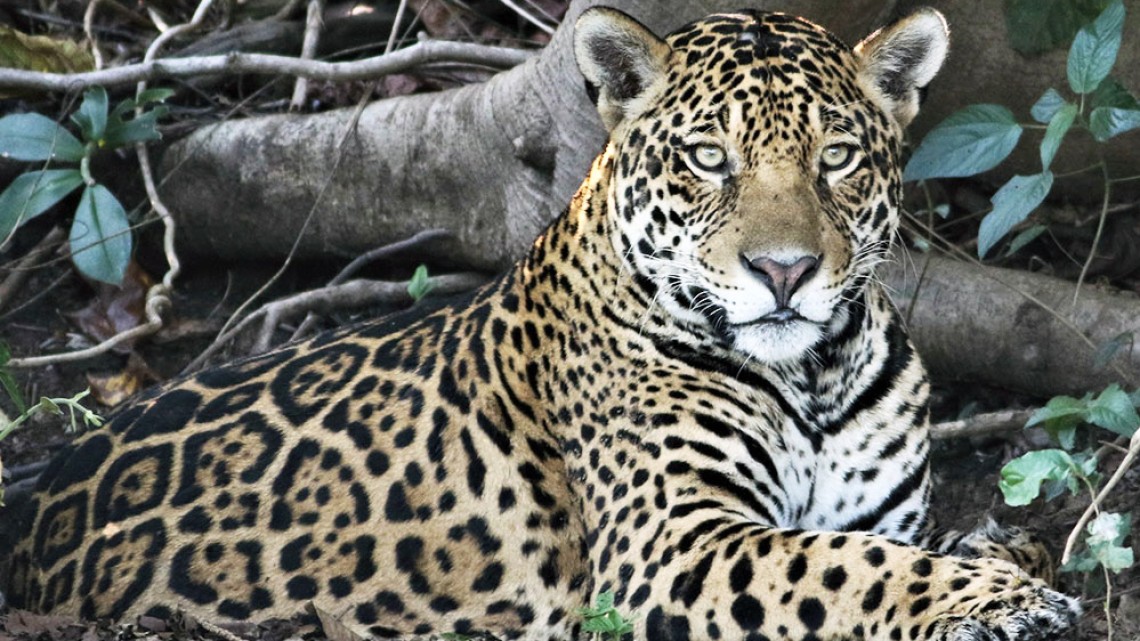
News directly from Cornell's colleges and centers
Stunning wildcat named in honor of Cornell
By -Pat Leonard
It was supposed to be a birdwatching trip, hosted by the Cornell Lab of Ornithology. But the most jaw-dropping sight for a group of alumni, staff, and supporters came four days into their trip and wasn’t a bird at all. They were treated to a close-up view of a stunning jaguar – the largest wildcat found in the Americas -- lounging amid the jungle greenery on the banks of the Miranda River in Brazil.
“My heart was in my throat,” said Bramble Klipple from the Cornell Lab, who captured video of the big cat. “Jaguars in this portion of Brazil, called the Pantanal, are not scared of people because hunting them is banned. It was one of the most amazing days!”
“I was holding my breath as our boat motored slowly past the shaded shoreline,” said Lab supporter Patricia Ryan, “Then there she was! So close, so big and powerful. Magnificent!”
But there’s more to the story. A South American ecotour and conservation company named SouthWild carefully monitors many of the jaguars in the Pantanal. The company confirmed that this animal had never been documented in the region before.
“We keep a photo gallery of every jaguar we have seen,” explained biologist Charles Munn, who founded SouthWild and led the tour. He has been studying the Pantanal cats continuously since 2005. “Every jaguar has unique markings, like fingerprints in humans. We had no record of this animal until the Cornell group documented it.”
Munn also determined that the jaguar was a female–and pregnant. SouthWild placed her in its registry under the name “Cornelia,” in honor of Cornell, at the suggestion of the birding group.
“It’s really special that this magnificent animal is named after the university,” said Ian Owens, executive director of the Cornell Lab, who was on this trip. “Cornell is synonymous with conservation efforts around the world. To have this spectacular animal carry the university’s name is a special honor.”
Cornelia wasn’t the first jaguar the group saw. They’d already seen two documented animals named Victoria and Hunter. But Victoria was long way off and the view was obstructed. Hunter was seen swimming and patrolling the riverbank, about 100 yards away. Seeing Cornelia was the most thrilling because she was closer--about 30 yards away.
“She appeared to be relaxed, albeit watchful,” said Cornell Lab Administrative Board member John Foote. “Cornelia is reasonably safe from human predators and appears to be in the prime of her life. Our hope is that she will lead a long life on the Miranda River.”
There are only about 185,000 of these secretive cats left in the wild. Many of them live in the Pantanal, the world’s largest tropical wetland, where they feast on abundant capybaras and caimans along the riverbanks. They are strong swimmers, can hunt day or night, and will kill and eat just about anything, having the most powerful bite for its size of any wildcat. Deforestation and poaching are the most severe threats they face.
Munn points out that the economic benefit of having living jaguars is far greater than killing them and has created more than 1,000 conservation and tourism jobs in this small region of Brazil. Some former poachers have even “converted” to knowledgeable guides. Munn says the number of jaguars in the region has increased, making it virtually guaranteed that visitors will see one or more.
Meanwhile, Cornelia is due to give birth to her cubs in early October. The SouthWild team will be taking photos over the next few months, though it may take some doing to find the cat family at first.
“Jaguar mothers keep their cubs very well hidden until they are four to five months old,” said Munn. “Then the cubs start walking with their mother in plain view. We’ll send baby pictures!”
Munn is an ornithologist, and with his guidance the group uploaded a list of 227 species into eBird. Still, he admits the power and beauty of the jaguar mesmerizes humans when it’s seen up close in the wild—one top predator meeting another.
“The Jaguar is the biggest conservation lever I have ever found to tug on,” Munn added. “I can generate huge conservation gains for many species, including the millions of songbirds that share the Pantanal with these big cats. I like to call the jaguar a ‘weapon of mass conservation!’”
Media Contact
Get Cornell news delivered right to your inbox.
Subscribe
